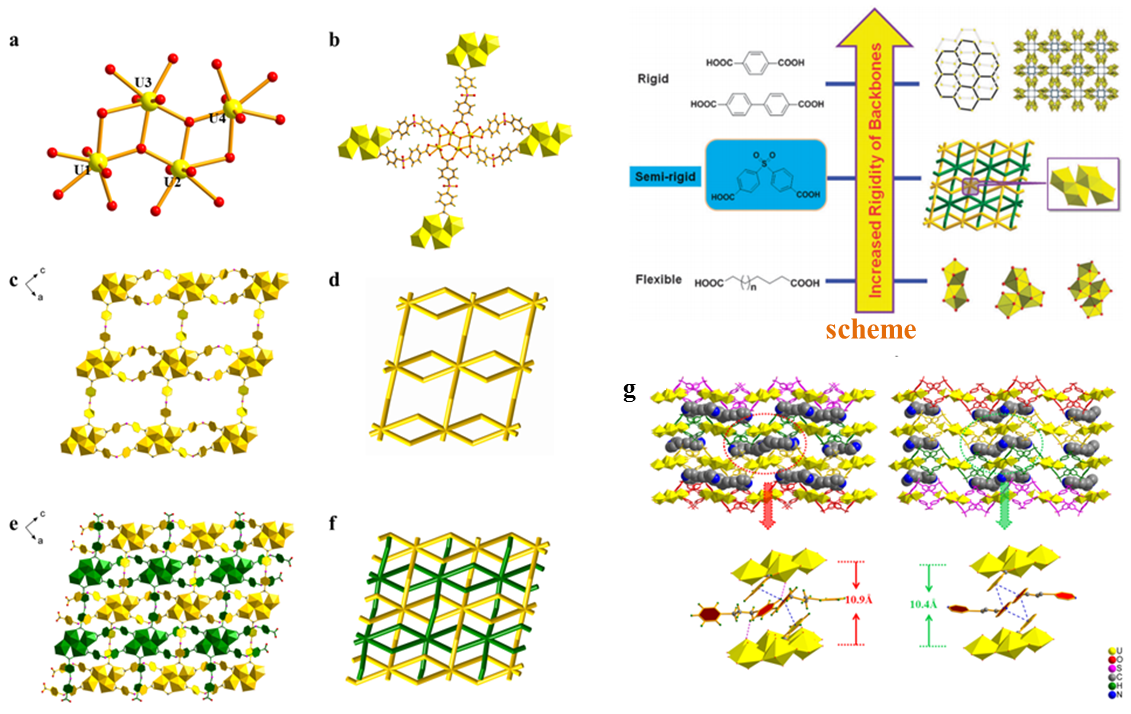| The templated synthesis of a unique type of tetra-nuclear uranyl-mediated two-fold interpenetrating uranyl–organic framework |
| From: PublishDate:2017-06-16 Hits: |
Metal-organic frameworks (MOFs) have drawn much attention due to their special structures and potential applications in the fields of adsorption, separation, molecular recognition and catalysis. The study on the structure design and properties of uranium-based organic frameworks, especially in uranyl form ([UO2]2+), dominate the actinide-organic materials. In contrast to numerous metal-organic materials based on transition metal and lanthanides, the strong tendency of uranyl ions to hydrolyze in aqueous or nonaqueous solvents not only result in the main difficulty in rationally control the coordination behaviours of the uranyl ions and ligands in the crystallization systems, but also, on the other hand, afford it various coordination patterns and abundant speciations. Shi’s group from Institute for High Energy Physics and Xia’s group have achieved the templated synthesis of a unique type of tetra-nuclear uranyl-mediated two-fold interpenetrating uranyl–organic framework. Their research has been published on January 28th, 2016 in Chemical Communications. (Chem. Commun. 2016, 52, 1641-1644.)
This group has found that an alteration of molecular backbones of ligands from rigidity to semi-rigidity or flexibility will be able to induce a transformation of uranyl secondary building unit from a monomer to an oligmer. On the other hand, a certain degree of rigidity of molecular backbone may guarantee the possibility to achieve interpenetration structures (scheme). So with the presence of an organic base, 1,3-di(4-pyridyl)propane (bpp), the team have successfully prepared two novel two-fold interpenetrating uranyl-organic compounds exhibiting tetrameric uranyl units, namely [U4O10(dbsf)3]2[H2bpp]2 (1) and [U4O10(dbsf)3][H2bpp] (2), from a semi-rigid organic ligands 4,4'-dicarboxybiphenyl sulfone (H2dbsf) under hydrothermal conditions, which represent the first report of tetra-nuclear mediated interpenetrating uranyl-organic networks. The results of X-ray single crystal measurements at Beijing Synchrotron Radiation Facility (BSRF) have revealed that compound 1 and 2 are two supramolecular isomers. Compound 1 crystallizes in the monoclinic space group P21/n, and two sets of similar tetra-nuclear uranium(VI) moieties coordinated by six dbsf2- ligands extended to two parallel wavelike networks interpenetrating to each other (Fig. a-f). The bpp ligands located between the adjacent two networks as template ligands and charge balancing agents (Fig. g). Compound 2 got only one type of similar network and the most difference come from the interactions between the bpp ligands and networks. In compound 1, the bpp ligands interacted with the networks by two hydrogen bonds (2.4167(102) ? and 2.4354(123) ? ), and the pyridine plane of the H2bpp2+ parallel to the adjacent dbsf ligands’ benzene planes with face-to-face cleft of 3.30 ? and 3.34 ?. In compound 2, the bpp ligands interacted with the networks only by similar face-to-face cleft, but the distance are 3.2303(4) ? and 3.2239(4) ?, which indicates stronger π-π stacking interaction than that in compound 1. The variation of the intermolecular interaction leads to the distance change of the adjacent 2D interpenetrating layers, from 10.9 ? in compound 1 decreasing to 10.5 ? in compound 2 (Fig. g). Compounds 1 and 2 represent the rare examples of supramolecular isomers in UOFs. Unlike transition metal based MOFs, the occurrence of uranyl supramolecular isomers should be attributed to the simple coordination mode of uranyl ions and slide of the template ligands. Then on this base, the team puts forward a new route in the construction of uranyl supramolecular isomer. Since the prediction of the whole crystal structure from starting materials is still practically impossible, rationalizing supramolecular isomerism of uranium(VI) by keeping the main crystallization conditions unchanged, and introducing the flexible template ligands may be a reasonable method.
Article: Shu-wen An, Lei Mei, Kong-qiu Hu, Chuan-qin Xia,* Zhi-fang Chai, and Wei-qun Shi*. Templated synthesis of a unique type of tetra-nuclear uranyl-mediated two-fold interpenetrating uranyl-organic frameworks. Chem. Commun. 2016, 52, 1641-1644. |
|
|
| Chinese
- Metal-free efficient photocatalyst for stable visible water splitting——Top ten major scientific progresses in China in 2015
- The nano-resolution imaging platform was awarded the first rate prize of Beijing Science and Technology in 2014
- Beamline 1W1 of BSRF started to runoperate in the couplingparasitic mode of BEPCII
- Synthesis of High Performance Polymer Materials for Field Effect-Transistors
- Surfactant molecular aggregates in green solvents
- GIXRD has played an important role in the characterization of organic thin-film transistors
Science Highlights
Home /
Copyright © 2011 - 2012 Beijing Synchrotron Radiation Facility


